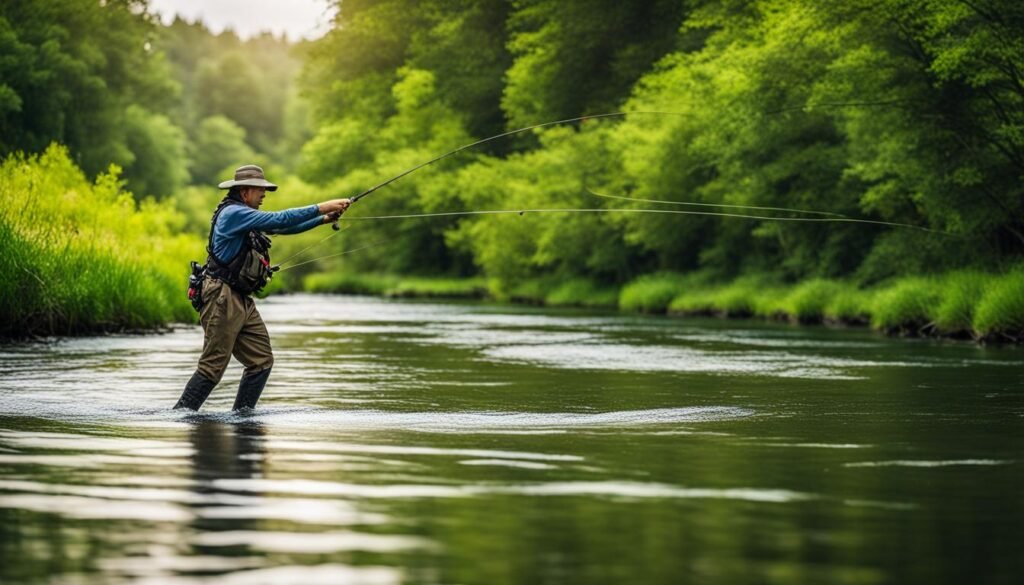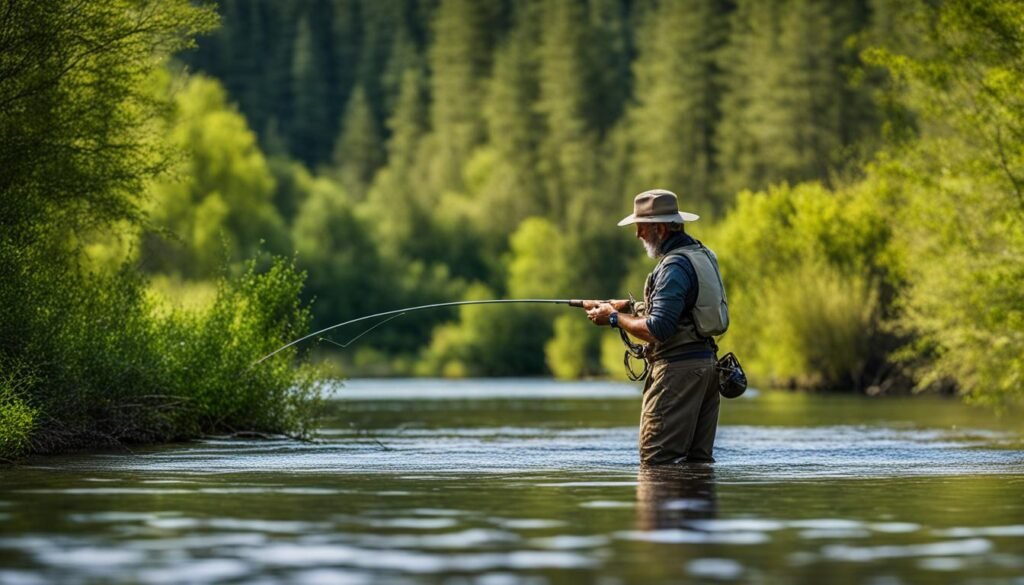Fly fishing is an ancient sport that combines the thrill of the catch with the serenity of nature. One of the most important casting techniques in fly fishing is the reach cast. In this ultimate guide, we will delve into the reach cast and provide you with tips and techniques to master this essential skill.
Understanding Fly Fishing Basics
Fly fishing is a unique and captivating angling technique that requires an understanding of its basic principles. Knowing the essentials of fly fishing will help you make informed decisions when it comes to selecting the right gear, flies, and techniques. In this section, we will explore the fundamental elements that form the building blocks of fly fishing.
Fly Fishing Gear
When it comes to fly fishing, having the right gear is essential for a successful and enjoyable experience. A fly rod is the backbone of your setup, and it’s important to choose one that matches your fishing style and target species. Rods are available in different lengths, materials, and actions, each suited for specific casting distances and fishing conditions. Pair your rod with an appropriate fly reel that balances the weight and complements the rod’s action.
Additionally, invest in a quality fly line and leader, as these components play a crucial role in casting accuracy and presentation. Fly lines come in various tapers and weights, and the right choice depends on factors like fishing location, target species, and casting preferences. Lastly, don’t forget about accessories such as fly boxes, nippers, and hemostats, which are essential tools for fly fishing enthusiasts.
Flies: Imitating Nature’s Prey
Flies are the heart and soul of fly fishing. These meticulously crafted creations mimic the insects or fish prey that fish feed on. Flies are available in a wide range of patterns, sizes, and colors to match different aquatic insects, baitfish, or crustaceans. As an angler, it’s crucial to have a diverse selection of flies in your arsenal to effectively imitate the natural food sources that fish target.
Flies can be classified into various categories such as dry flies, nymphs, streamers, and wet flies. Each type of fly serves a specific purpose and is used in different fishing scenarios. Dry flies float on the water’s surface and imitate adult insects, while nymphs imitate underwater insects and are fished below the surface. Streamers imitate baitfish or larger aquatic prey and provoke aggressive strikes from predatory fish. Wet flies are versatile patterns that imitate various stages of aquatic insects and attract fish throughout the water column.
Understanding Rod Action
The action of a fly rod refers to how it flexes and responds when casting and fighting fish. Rod actions can be classified as slow, medium, or fast, each offering distinct advantages and considerations. Slow-action rods flex more throughout their length and are forgiving, making them ideal for delicate presentations and smaller fish. Medium-action rods provide a balance between flexibility and power, making them versatile options for a wide range of fishing situations. Fast-action rods are stiff and deliver higher line speeds, making them perfect for casting in windy conditions or targeting larger fish.
Mastering the Reach Cast
The reach cast is a valuable technique in fly fishing that allows for accurate and drag-free presentation of the fly. By understanding and mastering this technique, you can greatly enhance your fishing success. Here, we will explore the reach cast in detail, including the steps involved, variations you can try, and the reach mend cast.
Steps to Perform the Reach Cast
- Start with a standard overhead cast, keeping your rod tip high and your line straight.
- Once the line is fully extended, perform an in-air mend towards the end of the forward part of the cast. This will introduce slack into the line, allowing for a longer drag-free drift.
- As the fly lands on the water, it will have a predetermined mend, providing a natural presentation.
Reach Cast Variations
While the basic reach cast is effective in many situations, there are variations you can experiment with to suit different fishing scenarios:
- Upstream Reach Cast: This variation is used when fishing upstream. Instead of making a straight overhead cast, you can angle the cast slightly upstream, allowing the fly to drift naturally downstream.
- Downstream Reach Cast: When fishing downstream, you can angle your cast slightly downstream. This will help prevent drag and allow for a longer drift.
Practicing and Perfecting Fly Casting

Mastering the art of fly casting requires practice and dedication. Whether you’re a beginner or an experienced angler, honing your casting skills is essential for success on the water. Here, we’ll explore various techniques and approaches to help you improve your fly casting abilities.
On-Water Practice
- Find a suitable fishing spot to simulate real-life casting scenarios.
- Perfect your accuracy by casting to different targets, such as logs or rocks.
- Experiment with different fly patterns and sizes to understand their impact on casting distance and presentation.
- Practice casting in varying weather conditions, such as wind and rain, to prepare yourself for challenging situations.
Off-Water Practice
- Use an open field or a calm lake to practice your casting technique when you can’t be on the water.
- Film your casting sessions or ask someone to film them for you. This allows you to analyze your technique and make necessary adjustments.
- Focus on specific aspects of your casting, such as loop control, timing, and power delivery, during off-water practice sessions.
- Seek guidance from professional guides or casting instructors to receive personalized feedback and guidance for improvement.
Advanced Fly Casting Techniques
Once you’ve mastered the reach cast, it’s time to expand your fly casting repertoire with some advanced techniques. These techniques will not only enhance your casting skills but also increase your chances of success on the water. Let’s explore a few of these advanced casting techniques:
The Steeple Cast
The steeple cast is perfect for situations where you have limited backcast space. It allows you to bring the line up in the air and cast forward, giving you more control and accuracy. This technique is particularly useful when fishing in tight spaces or when there are obstacles behind you, such as trees or bushes.
The Pile Cast
The pile cast is a great technique for presenting your fly across currents or in back eddies. By intentionally creating slack in your line during the cast, you can allow the fly to land softly on the water and drift naturally. This can be especially effective when targeting fish that are feeding close to the surface or in slower-moving water.
The Single Haul
The single haul is a technique used to increase line speed and power, particularly in windy conditions. By adding a quick, forceful pull with your line hand during the casting stroke, you can generate more energy and achieve greater distance and accuracy.
Bow and Arrow Cast
The bow and arrow cast is a handy technique for casting in tight quarters. It involves holding the line between your thumb and index finger, creating tension, and then releasing it quickly to propel the fly forward. This technique is perfect for fishing in small streams or when there are obstacles overhead.
The History of Fly Fishing
Fly fishing is an ancient sport that has captivated anglers for centuries. Its origins can be traced back to Macedonia in 200 CE, where the earliest records of fly fishing were found. From there, the sport gained popularity in Europe during the 15th and 16th centuries, thanks to the influence of English and Scottish anglers. When European settlers arrived in North America, fly fishing made its way across the Atlantic, becoming particularly prevalent in regions like Pennsylvania, Newfoundland, and Cape Cod.
The development of the railroad in the 19th century further fueled the growth of fly fishing. The accessibility provided by the railway connected fly fishing hotspots, like the Catskills in New York state, to major cities, making it easier for enthusiasts to travel and explore new waters. With time, fly fishing techniques and equipment evolved, leading to the modern development of the sport as we know it today.
The Ancient Sport of Fly Fishing
- Originated in Macedonia in 200 CE
- Popularized in Europe during the 15th and 16th centuries
- Introduced to North America by European settlers
A European Influence
- English and Scottish anglers played a significant role in spreading fly fishing
- Fly fishing became prevalent in regions like Pennsylvania, Newfoundland, and Cape Cod
Modern Development and Accessibility
- The development of the railroad in the 19th century connected fly fishing hotspots
- Improved accessibility allowed for easier travel and exploration
- Fly fishing techniques and equipment continued to evolve over time

